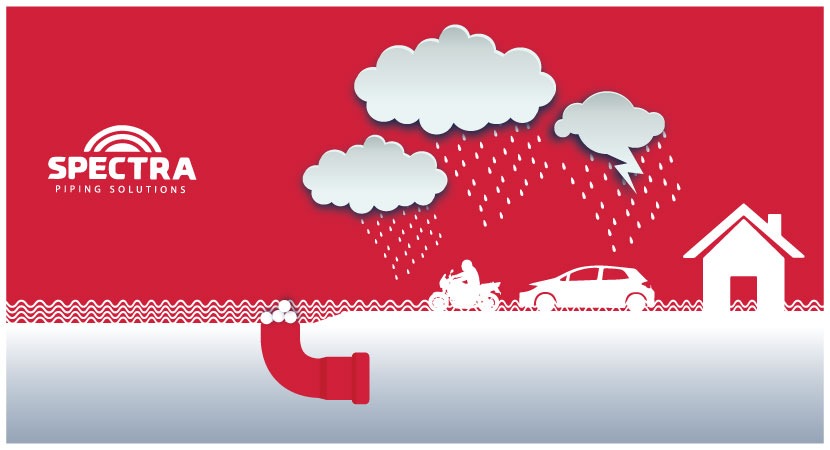Come monsoon and waterlogging is an obvious conclusion as far as Indian cities go. Every metro in India welcomes monsoon only to be faced by a nightmarish consequence of the same, leading to disaster and destruction. In 2005, the vibrant city of Mumbai came to a standstill as flooded streets made it impossible for commuters and school kids to reach home. Mumbaikars were stranded for hours and days and approximately 5000 lives were lost in the process. Chennai too bore the brunt of heavy rainfall in December 2015, and the subsequent inundation of the low-lying areas of the city led to a loss of lives and a shutdown of business and public amenities for days.
These are just two examples cited from recent history. There have been, of course, numerous unfavourable outcomes of nature’s fury in our country that have to do with unplanned urbanization. Illegal construction and unregulated urban planning are the biggest foes of the safety of citizens during monsoons. Of course, the respective municipal corporations have received a great deal of criticism with respect to the mismanagement of drainage and land encroachment and other factors that have contributed to a sad state of affairs. This situation has been summarised very well in Sunita Narain’s words, who is the director of the Centre for Science and Environment (CSE) think tank – “We have forgotten the art of drainage. We only see land for buildings, not for water.”
What causes such irreversible damage that repeats itself year after year?
This phenomenon of an uncontrolled and rampant rise in water levels that floods the roads and streets are called urban flooding. Urban flooding is caused by a lack of drainage management in an urban region. Due to a dearth of open soil for water absorption, the rainfall precipitation will either be transported to surface water drains or the sewage systems. But more than often in Indian metros, the sewage systems remain blocked due to manmade reasons like deposits and waste that are non-degradable. Over usage and improper disposal of waste products that are not eco-friendly, is one reason for water clogging. Open spaces are shrinking as trees are being cut down to accommodate real estate needs due to colossal human migration to big cities. Climate change, too, has its own contribution to this problem. Hence, when a region experiences high-intensity rainfall, the city sewage system and draining canals are unable to carry the heavy deluge of rainwater. Water enters the sewage system and can spill over to the streets. Most importantly, storm drainage systems and surface drainage systems have not been planned and maintained to tackle huge downpours in major cities.
How can urban flooding be prevented?
Following are a few possibilities amongst many to prevent urban flooding:
-
Rainwater Harvesting
-
Building Green Roofs
-
Separate Rainwater from Sewer Systems
-
Infiltration for Sustainable Drainage
1. Rainwater Harvesting
Mr. Vinod Kumar Jain, director of NGO Tapas who has helped revive water bodies around the Delhi region says that rainwater harvesting can play a significant role in reducing the chances of flooding in urban areas. Rainwater harvesting is essentially trapping, conserving and harnessing of rainwater for later usage.
2. Building Green Roofs
Green roof systems are the panacea for highly urbanised cities to build an effective defence against rainwater flooding. They are an effective stormwater management tool, reducing stormwater runoff and preventing sewer overflow at the bottom level. Green roofs have multiple environmental benefits both for public and private use. They have proven to be a success globally, as a preventive measure for urban flooding.
3. Separate Rainwater from Sewer Systems
To improve water management and protect the sewer system from damage, underground pipe and drainage systems can be revamped to separate rainwater from the Sewer System. Wastewater treatment can function effectively with such a system without burdening surface pipe systems with stormwater.
4. Infiltration for Sustainable Drainage
Cement and other impermeable surfaces do not allow enough water absorption during rains. If sidewalks are replaced with porous and permeable materials that allow the rainwater to drain into the soil, the ecological balance of the region can be preserved to some extent. Infiltration also serves to sustain the plant life.
Steps such as rainwater harvesting, using permeable surfaces while building public property, and better use of weather forecasts will go a long way in helping tackle flooding in cities after rains. The civic authorities can no longer afford a lackadaisical attitude towards this gigantic burden that city dwellers have to bear each time monsoon hits the country.
Spectra brings a unique advantage in soil, waste and rainwater (SWR) drainage systems. Spectra’s SWR drainage systems are designed for quick and efficient removal of soil, waste and rainwater without leakage. They are highly resilient, tough and durable with high tensile and impact strength. These systems have a long service life and are widely used in residential and commercial establishments. They are cost-effective, durable and have excellent chemical & corrosion resistance, making them ideal for stormwater drainage. Find out more about Spectra pipes and fittings Click here.
To Know more about Water Scarcity in Rural India, Kindly read our Water Scarcity in Rural India – A Perspective.


